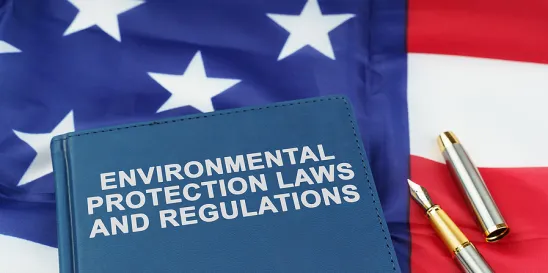On February 7, 2024, the U.S. Environmental Protection Agency (EPA) released its Final Rule lowering the primary annual National Ambient Air Quality Standard (NAAQS) for fine particulate matter (PM 2.5) from the current level of 12 micrograms per cubic meter (μg/m3) to 9 μg/m3. Once published, the Final Rule is certain to be challenged in court. With that caveat, we summarize below the planned implementation and potential impacts of the new standard on sources of PM 2.5 or PM 2.5 precursor emissions. For more background, see our prior post about EPA’s 2023 proposal to lower the NAAQS and sources of PM 2.5.
Implementation
The Final Rule will take effect 60 days after notice of the Final Rule is published in the Federal Register. As of the date of this post, publication has not yet occurred.
To implement the new PM 2.5 NAAQS, the first step is for each state to develop recommended designations of areas in the state as attainment or nonattainment with respect to the new standard. According to the anticipated timeline in a February 7, 2024 memo from EPA Air chief Joseph Goffman, states would have until February 7, 2025 to submit these recommended designations to EPA. Following EPA review, public comment, and any necessary revisions, designations would be finalized in February 2026. The memo also notes that based on certain Clean Air Act provisions, EPA will initially classify all PM 2.5 nonattainment areas as “Moderate.” Thereafter, any such areas must achieve attainment by the end of the sixth calendar year after the effective date of the designation. EPA expects that 2032 is likely the earliest possible attainment deadline.
Based on 2016-2020 air quality data, and incorporating expected emission reductions from various programs (existing and planned) across the country, EPA projects that more than 99% of counties will attain the tightened annual PM 2.5 standard by 2032. As shown below, the most impacted state per EPA’s 2032 nonattainment projections is California, particularly the Central Valley and southern California. Remaining projected nonattainment areas are highly scattered across the lower 48 states, and include several major urban areas.

Source: https://www.epa.gov/system/files/documents/2024-02/2024-pm-naaqs-final-2032-projections-map.pdf
However, projections using more recent data – on which EPA has said it expects states to base their attainment designation recommendations – suggest that the 9.0 μg/m3 standard could present much more widespread challenges. According to a recent report by the U.S. Chamber of Commerce (Chamber), average annual PM 2.5 emissions increased significantly from 2019 to 2023 across most of the eastern United States, and most of the country saw significant increases in ambient concentrations of PM 2.5 (as much as 2 to 3 μg/m3) in 2023 due to widespread wildfires.
Using data from 2021-2023, the Chamber considered how counties across the contiguous United States might fare under a 9.0 μg/m3 standard. Counties shown in red on the map below are those which would not meet the new standard, and therefore are vulnerable to a nonattainment designation, even if projected to reach attainment by 2032. Because of the wildfire-related PM 2.5 spike in many areas of the country in 2023, it is expected that many states will ask EPA to apply its “exceptional events” policy to reduce their attributed PM 2.5 levels and avoid nonattainment designations.
Counties shown in green on the map below are those projected by the Chamber to attain 9.0 μg/m3 with “headroom” to spare (≥3 μg/m3, even before from any downward adjustment under EPA’s “exceptional events” policy).
The remainder of the country, shown in light red, is projected by the Chamber to fall 1 to 3 μg/m3 below the new standard, and would presumably be designated as attainment. But being designated attainment is one thing; maintaining attainment is another. Absent downward adjustment from EPA’s “exceptional events” policy, PSD permitting authorities will likely be more wary of permitting additional emissions of PM 2.5 or PM 2.5 precursors that consume a significant share of the headroom remaining under 9.0 μg/m3 and, in the aggregate, could lead to a violation of the new NAAQS.

Source: https://www.globalenergyinstitute.org/sites/default/files/2023-11/Chamber PM2.5 Report _ 11.8.23 Final Draft.pdf
Further Potential Impacts
In addition to the potential impacts discussed above, the new NAAQS, once effective, will have an immediate impact on certain pending permit applications for PM 2.5 or PM 2.5 precursors in areas currently designated as attainment under the 12 μg/m3 NAAQS and prior PM 2.5 NAAQS. In such areas, Prevention of Significant Deterioration (PSD) permitting for construction of a new major stationary source or a major modification of an existing stationary source (as defined in EPA and state PSD regulations) under those NAAQS will continue to apply. However, once the Final Rule takes effect, pending, as well as future, PSD permit applicants for a PM 2.5 or a PM 2.5 precursor source will need to incorporate the new standard into their air quality impact analyses. More specifically, applicants will need to demonstrate that their source will not cause or contribute to an exceedance of the 9 μg/m3 NAAQS, as well as the 12 μg/m3 NAAQS and prior standards.
In areas ultimately designated as nonattainment under the new NAAQS, the permitting impacts would be more severe. Under the Clean Air Act, construction of a new major stationary source of PM 2.5 or a PM 2.5 precursor or a major modification of an existing major stationary source would be subject to Nonattainment New Source Review permitting, which requires stringent emission controls and offsetting emission reductions elsewhere at the source or at other sources. Existing major sources that do not undergo a major modification would be subject to Reasonably Available Control Measures, including Reasonably Available Control Technology (RACM/RACT).
Other Features of the Final Rule
As in the proposed rule, the Final Rule retains all other existing particulate matter NAAQS (the primary 24-hour PM 2.5 standard and the identical secondary standard; the secondary annual PM 2.5 standard; and the primary 24-hour coarse particulate matter (PM 10) standard and its identical secondary standard). Although EPA solicited comments regarding reducing the 24-hour PM 2.5 primary and secondary standards from the current 35 μg/m3 to as low as 25 μg/m3, the agency determined that the existing standards already provide “appropriate supplemental protection against elevated peak concentrations of fine particles.” In justifying this decision, EPA emphasized its holistic evaluation of the public health protections offered by the full suite of PM standards.
The Final Rule also provides for adjustments to the nationwide PM 2.5 monitoring network, with an environmental justice focus: when siting monitors, monitoring agencies must consider the proximity of sensitive communities to PM 2.5 emission sources of potential concern.
* * * * *
This summary highlights some of the many unknowns regarding the new NAAQS at this early stage. Subject to the outcome of expected legal challenges to the standard, the next few years should clarify its impact on permitting and other regulation of PM 2.5 and PM 2.5 precursor sources.




 />i
/>i

